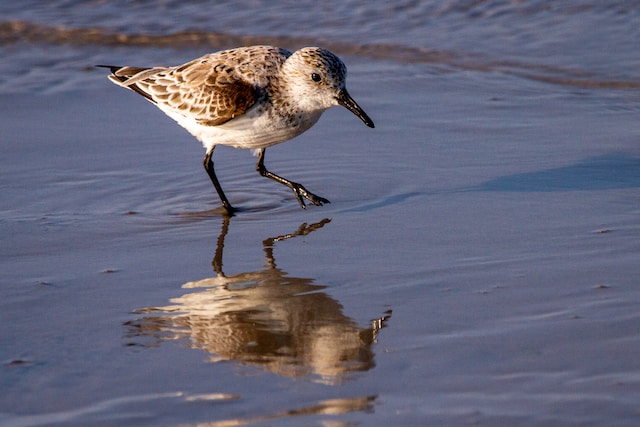April is National Poetry Month, so in honor of that, I’m going to share one way that dabbling in poetry can help your fiction. Specifically, have you ever considered using poetry as a way to find distinct voices for your characters?
Years ago, I attended a short workshop by Lance Larsen, poet laureate for Utah at the time. Pictures of animals lay scattered on the tables before us, and we had to pick an animal and write a short poem from that animal’s point of view.
I chose a seabird. And immediately felt intimidated. I’m a fiction writer. I wasn’t sure how to craft a poem out of a seabird and a blank page. Eventually, though, I began to imagine my little sandpiper playing at the edge of the sea. In my mind, I watched it skitter away from the waves on its long, skinny, lightning-fast legs. I saw the laced edge of each wave chase the bird up the sand. I saw the bird chase the wave back.
I imagined what it might sound like. What it was looking for. What the waves felt like, frothing and foaming on the sand.
And I began looking for words to try to capture that movement, those sounds, the sunlight sparkling off the water.
After a few minutes, I had an unexpected poem. Then I put that poem away in a digital drawer.
As the years passed, I kept remembering that poem. And then, one day, I was thinking about a new character in a new novel I’d begun. And that poem came back to me.
There it was—my character’s voice. The quick, darting movements. The perceptive bright eyes. The magic sense of sky, sand, and sea. The nimble, light-filled language.
What sets poetry apart from fiction is the word choice, imagery, emotion, and rhythm. Oh, wait. Those elements are just as crucial in fiction as they are in poetry, right? In fact, the line between the best poetry and the best fiction often blurs.
The difference between them may simply be that poetry must be more concentrated because it has fewer pages to tell its story.
In a poem, everything is pared away to tendon, muscle, and bone. No fat remains. No filler. Precious little connective tissue. Every single image, concept, line, and word in a poem can only exist in that poem because the poem would simply collapse without it. What you should be left with is super-concentrated, distilled, and potent language that drives you straight to the point, or the heart, or the fear. Nothing is wasted in a poem. Sound, rhythm, beat, pause—all weave together to create a poem.
As they do to create a work of fiction.
That sense of distilling language to a potent brew is exactly what you need to define your character’s voice.
Think about one of your characters, and choose an animal you think closely resembles them. Then consider the sounds that animal makes, the ways they move, the environments they feel most comfortable within.
Forget about your character completely, and write a poem from that animal’s point of view. Say you’ve chosen a bear. Try playing with words that sound like your bear: perhaps the words you select sound guttural, short, deep-throated, blunt, single syllables with long vowels and harsh consonants. Does the bear lumber through life, until it’s cast into sudden rage by an invader? Show that movement—how does the bear walk, sit, brush branches aside, crush flowers beneath its feet, sniff at a beehive? How does it loom large, blocking the sunlight, when angry? Spend time with this bear, and write its poem.
Then move on to another character—the villain, perhaps, or a secondary character. Do they remind you of a parrot, all bright colors and mimicry and pretty words without substance? Or maybe a snake? A gecko? A new colt? An old badger? Write that animal’s poem. Don’t think about the character. Just focus on the animal and write your poem from the animal’s point of view.
With each animal’s poem, chances are good you’ve created a new voice. You’ve thought about syntax and rhythm and the sounds words make on your tongue and in your head. It’s almost a physical feeling, right? The language in your poem should move as they move, sound as they sound, speak as they speak.
Next, take each animal’s rhythms, sounds, and movements and incorporate them into your characters.
Then stand back and watch as each character in your story reveals and embraces their own unique, unmistakable voice, and the layers in your story grow richer, deeper, and more compelling.
Happy National Poetry Month!
[Photo by Joshua J. Cotton on Unsplash]


Love this. Thank you for the suggestions.